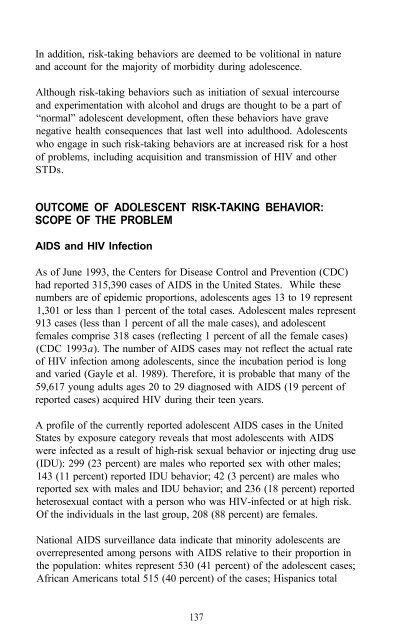The Context of HIV Risk Among Drug Users and Their Sexual Partners
The Context of HIV Risk Among Drug Users and Their Sexual Partners
The Context of HIV Risk Among Drug Users and Their Sexual Partners
Create successful ePaper yourself
Turn your PDF publications into a flip-book with our unique Google optimized e-Paper software.
In addition, risk-taking behaviors are deemed to be volitional in nature<br />
<strong>and</strong> account for the majority <strong>of</strong> morbidity during adolescence.<br />
Although risk-taking behaviors such as initiation <strong>of</strong> sexual intercourse<br />
<strong>and</strong> experimentation with alcohol <strong>and</strong> drugs are thought to be a part <strong>of</strong><br />
“normal” adolescent development, <strong>of</strong>ten these behaviors have grave<br />
negative health consequences that last well into adulthood. Adolescents<br />
who engage in such risk-taking behaviors are at increased risk for a host<br />
<strong>of</strong> problems, including acquisition <strong>and</strong> transmission <strong>of</strong> <strong>HIV</strong> <strong>and</strong> other<br />
STDs.<br />
OUTCOME OF ADOLESCENT RISK-TAKING BEHAVIOR:<br />
SCOPE OF THE PROBLEM<br />
AIDS <strong>and</strong> <strong>HIV</strong> Infection<br />
As <strong>of</strong> June 1993, the Centers for Disease Control <strong>and</strong> Prevention (CDC)<br />
had reported 315,390 cases <strong>of</strong> AIDS in the United States. While these<br />
numbers are <strong>of</strong> epidemic proportions, adolescents ages 13 to 19 represent<br />
1,301 or less than 1 percent <strong>of</strong> the total cases. Adolescent males represent<br />
913 cases (less than 1 percent <strong>of</strong> all the male cases), <strong>and</strong> adolescent<br />
females comprise 318 cases (reflecting 1 percent <strong>of</strong> all the female cases)<br />
(CDC 1993a). <strong>The</strong> number <strong>of</strong> AIDS cases may not reflect the actual rate<br />
<strong>of</strong> <strong>HIV</strong> infection among adolescents, since the incubation period is long<br />
<strong>and</strong> varied (Gayle et al. 1989). <strong>The</strong>refore, it is probable that many <strong>of</strong> the<br />
59,617 young adults ages 20 to 29 diagnosed with AIDS (19 percent <strong>of</strong><br />
reported cases) acquired <strong>HIV</strong> during their teen years.<br />
A pr<strong>of</strong>ile <strong>of</strong> the currently reported adolescent AIDS cases in the United<br />
States by exposure category reveals that most adolescents with AIDS<br />
were infected as a result <strong>of</strong> high-risk sexual behavior or injecting drug use<br />
(IDU): 299 (23 percent) are males who reported sex with other males;<br />
143 (11 percent) reported IDU behavior; 42 (3 percent) are males who<br />
reported sex with males <strong>and</strong> IDU behavior; <strong>and</strong> 236 (18 percent) reported<br />
heterosexual contact with a person who was <strong>HIV</strong>-infected or at high risk.<br />
Of the individuals in the last group, 208 (88 percent) are females.<br />
National AIDS surveillance data indicate that minority adolescents are<br />
overrepresented among persons with AIDS relative to their proportion in<br />
the population: whites represent 530 (41 percent) <strong>of</strong> the adolescent cases;<br />
African Americans total 515 (40 percent) <strong>of</strong> the cases; Hispanics total<br />
137
















